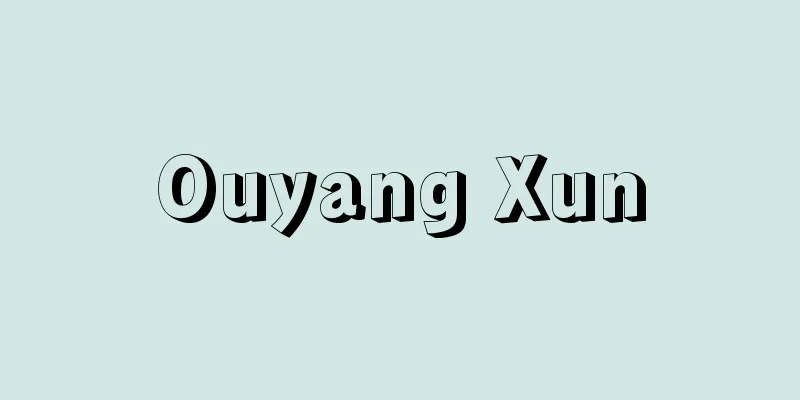Ouyang Xun

|
A representative calligrapher of the Tang Dynasty in China. Along with Yu Shinan and Chu Suiliang, he is known as one of the three great calligraphers of the early Tang Dynasty. He was from Linxiang, Tanzhou (Hunan Province). He was the son of Ouyang He, the governor of Guangzhou in the Chen Dynasty, and his pen name was Xinben. He lost his father at a young age and was raised by his father's friend, Jiang Zong. He was naturally intelligent and well versed in classics and historical records, and served Emperor Yang of Sui as a Taichang scholar. When the Tang Dynasty rose to power and Emperor Gaozu ascended to the throne, he was selected as a member of the staff and, in 624 (the 7th year of the Wude era), he compiled the 100-volume "Geimon Ruiju" (Collection of Arts and Letters) by imperial order together with Pei Ju and Chen Shuda. After Emperor Taizu ascended to the throne, he became a scholar at the Kobunkan School, served as the Crown Prince's Special Commissioner and Bohai Man, and was appointed as the Guanglu Daifu (Grand Master). He died in the 15th year of the Zhenguan era at the age of 85. He is said to have excelled in various styles of calligraphy, including Hihaku and Tensho, but among the remains that can be seen today, his regular script is the most outstanding, and among them, the "Huadoji Monument" and the "Kyuseikyureisen no Mei" are masterpieces that have been praised since ancient times as the "ultimate standard of regular script." Other works that remain include the "Huangfu Tan Monument," the "Ongenbaku Monument," and the "Shijishu." His son Ouyang Tong (?-691) was also known as a skilled calligrapher, and the calligraphy of this father and son, which was imported by Japanese envoys to the Tang Dynasty, had a significant influence on calligraphy from the Asuka to the Heian periods in Japan. [Shigeru Matsubara] Source: Shogakukan Encyclopedia Nipponica About Encyclopedia Nipponica Information | Legend |
|
中国、唐代を代表する書家。虞世南(ぐせいなん)、褚遂良(ちょすいりょう)とともに初唐の三大家と称される。潭州(たんしゅう)臨湘(りんしょう)(湖南省)の人。陳の広州刺史(しし)欧陽紇(おうようこつ)の子で、字(あざな)は信本(しんぽん)。幼時に父を失い、父の友人江総のもとで養育された。生来聡明(そうめい)で、経書や史籍に通じ、隋(ずい)の煬帝(ようだい)に仕えて太常(たいじょう)博士となった。唐が興り高祖が即位すると、給事中に抜擢(ばってき)され、624年(武徳7)、勅命により、裴矩(はいく)、陳叔達(ちんしゅくたつ)とともに『芸文類聚(げいもんるいじゅう)』100巻を撰進(せんしん)。ついで、太祖即位後は、弘文館(こうぶんかん)学士となり、太子率更令(そつこうれい)、渤海男(ぼっかいだん)を経て、光禄大夫(こうろくたいふ)に任ぜられる。貞観(じょうがん)15年に85歳で没。書は飛白(ひはく)や篆書(てんしょ)以下各体をよくしたといわれるが、今日にみる遺品のなかでは楷書(かいしょ)がもっとも優れ、なかでも『化度寺碑』と『九成宮醴泉銘(きゅうせいきゅうれいせんのめい)』とは古来「楷法(かいほう)の極則」とまで賞賛されてきた名品。ほかに『皇甫誕(こうほたん)碑』『温彦博(おんげんはく)碑』『史事帖』などの作品が残る。子の欧陽通(?―691)も能書家として知られるが、遣唐使らによって舶載された彼ら父子の書法は、わが国の飛鳥(あすか)から平安時代の書にも少なからぬ影響を与えている。 [松原 茂] 出典 小学館 日本大百科全書(ニッポニカ)日本大百科全書(ニッポニカ)について 情報 | 凡例 |
Recommend
Kamogawa Dance - Kamogawa Dance
A dance performance by the geisha ensemble of Pont...
Unified Field Theory - Toitsubariron
An attempt to derive the necessity for the existe...
Laelia crispa (English spelling)
...This hybrid flowered in 1856 and was named C. ...
Fukiagehama Beach
This refers to the coastal sand dune area on the ...
Diffusion (respiration) - Kakusan
…Whether respiratory function is sufficient is ul...
Homologus
…Under these circumstances, it was H. Poincaré wh...
Primary dendrite - ichiji dendrite
…The growth rate of the solid phase differs depen...
Poll tax - Jintouzei
A taxation system existed in Okinawa until 1902 (...
Electric (electric) - ereki
...electrical knowledge brought to Japan through ...
Ohno (Aichi) - Ohno
...A ceramics city located in the central west co...
Ariake [town] - Ariake
A former town in Soo County in eastern Kagoshima P...
Concrete pump
...There are non-tilting drum mixers and tilting ...
Itari cooking - Itari cooking
...In the early modern period, while cranes were ...
psychedelic rock
...(4)Country rock: Both Dylan and the Byrds appr...
Harihara
…It was succeeded by four different royal lines: ...









